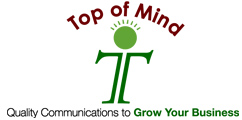3 STEPS TO PERSUASIVE PROPOSALS
3 Steps to Persuasive Proposals

Craft your business proposals with a client-centric focus. That means a single-minded emphasis on the prospect’s needs. Success in that effort will be enhanced with a 3-step roadmap that will put you head and shoulders above the competition and truly prevail in the eyes of decision-makers.
Those three steps are:
- Expose
- Propose
- Close
Step 1 – Expose
In simplest terms … do your homework. Your job on the front end is to demonstrate that you have a firm grasp on what the client’s business is all about as well as the key issues or challenges that are to be addressed.
Note: In Step 1, it is not your company’s history or capabilities that are to be exposed!
The vast majority of proposals start with a recitation that focuses on the vendor. You’ll get a chance to toot your own horn, but not in the beginning paragraphs of the Executive Summary or body of the proposal.
In this high-tech, digital age there is another reason for not leading with “let me tell you all about me”. Studies are clear that 70% – 80% of choosing a prospective vendor is done by the client before reviewing a proposal. Your website, LinkedIn profile and Google will be researched beforehand.
Likewise, you will perform your due diligence by becoming well versed in the origins, functions and current client challenges. As part of this process, be sure to seek out information about the primary decision-makers and influencers who will be involved in evaluating your proposal. That can help you to position your solutions to speak to the needs of those stakeholders. Social media and Google are your most powerful allies in this quest.
Step 2 – Propose
Having clearly stated your understanding of the client and its needs, the next step is to present solutions consistent with the client’s expectations and desired outcomes. That will be the foundation for your unique selling proposition and value-add rationale.
Now this is critical. The results the client wants and needs is not whatever product or service you are selling. An example: Your service might be website design and you are masterful at that. The client may only be concerned with building market share and increasing on-line sales. The website is merely a tool to achieve those ends. So, your story needs to address the needs as perceived by the client – not a puff piece about your superior technical skills.
- Equally important to you is to create additional impact for your prospect based on anticipated ROI … return on investment. That must relate directly to needs satisfaction and be quantifiable in ways meaningful to the decision-makers. Buying decisions are universally made around one or more of the following four benefits:
- Save Money
- Make Money
- Save Time
- Peace of Mind
Liberally weave these into your proposed solutions. You will demonstrate that you deliver more than just your product or service … you deliver value.
Tom Sant is touted as being the foremost expert of proposal writing. He offers critical guidance on two elements of delivering a proposal – length and timing – both related.
Sant’s firm conducted a test with people who make their living evaluating proposals. They were presented with three proposals of 25 pages, 50 pages and 100 pages respectively. The objective was to see which one was picked up first. Invariably, the shortest one won out.
The corollary to this experiment is that the client will inevitably compare the second and subsequent proposals to the first one read. Not as good as yours … you win. So, be first-read and become the standard by which others will be judged.
It’s a proven fact, while we all purport to be objective in our decision making, we make our buying decisions emotionally and later justify them logically. The significance of this element of human nature is that you must arouse feelings of what the solution will deliver as well as the features and benefits.
On that point, consider the difference between power words and weasel words. Power words are a call to action. Weasel words engender doubt.
Click here and enjoy an article and a quick quiz with a dozen words that could change your life and maximize your proposal communication effectiveness.
So, in your proposal writing:
- Demonstrate clarity of understanding of the client and its needs.
- Deliver solutions that match the client’s perception of desired outcomes.
- Create impact with a quantified ROI.
- Write with brevity, simplicity and arouse feelings, not just analysis.
Click Here for an excellent brief video of a Tom Sant presentation on selling and proposal writing.
Step 3 – Close
Now’s the time to strut your stuff, toot your horn and close the loop on why your company is the premier choice to deliver on the client’s needs.
What are the pieces and parts of your close?
- Restate your grasp of the company and its challenges.
- Define the solutions in-synch with the client’s measures of success.
- Show proof of your successes with similar projects.
- Include testimonials and offer references as requested.
- List pertinent certifications, training or relevant education history.
- Provide cost and time-frame estimates that are real … not overly ambitious.
- Specify benchmarks and payment schedule.
- Quantify the upside ROI to validate the investment … money saved, time efficiencies yielding reduced costs, revenue increased, and elimination of stress.
Properly written, your Close will detail for your prospect the “What’s In It For Me” message, meaning all they will enjoy from choosing you as the vendor.
Hind End Foremost – Now For the Executive Summary
Tom Sant shares a great story about a client’s experience with one of their sales proposals. After winning a major contract, a conversation with one of the decision-makers revealed that, “Your executive summary was so good, we knew we were going to award the contract to you by the time we got to page two.”
The Executive Summary is the grounding of your proposal because that’s the one section everybody will read. It is likely that your Close will be the chief resource for the content of your Executive Summary. Remember, make it short, concise, tightly written and demonstrate your firm understanding of the company, its challenges, solutions and payoffs to choosing you.
Red Flags and Cautions
There are a few risk avoidance items that are worth your consideration.
- Moving Too Quickly: It can be flattering to be requested to prepare a sales proposal. The key thing is to be sure that it is a valid request from a qualified prospect with an identified need. That said, be alert to the possibility that the proposal invitation may be to slow down the velocity of the sales process, i.e. not ready to buy. Another concern is whether the prospect will invest time on the front end to help you clarify and comprehend their needs. Finally, you will want to know the decision-making protocol, budget approval process and ideally an introduction to the key decision-makers and influencers.
- Your cover letter should be a mini-version of your Executive Summary.
- Your cover page should not refer to the document as a “Proposal”. For example, it might read as “Comprehensive Solution to Regain Lost Market Share and Enhance Revenue Margins”. Which has more impact?
- Depending on the length of the proposal, include a table of contents with page numbers that correspond to the body of the document.
Summary
- Do your homework.
- Demonstrate clarity of understanding of the client and its needs.
- Deliver solutions that match the client’s perception of desired outcomes.
- Create impact with a quantified ROI.
- Write with brevity, simplicity and arouse feelings, not just analysis.
- Provide attractively bound hard-copies for all client reviewers. That’s a differentiator to make you stand out in this digital age.
Additional Resources
- Proposal Templates
- Books by Tom Sant
- Google “Business Proposal Templates”
